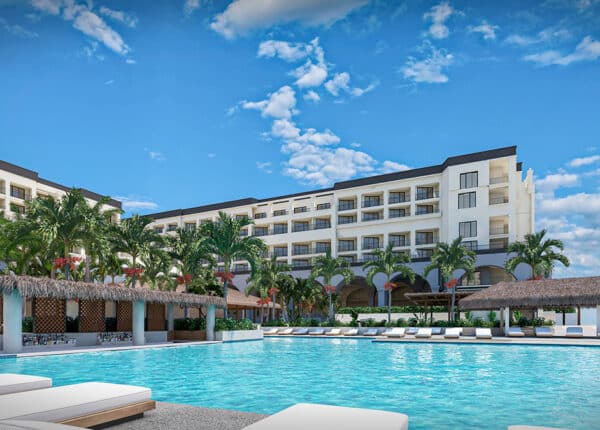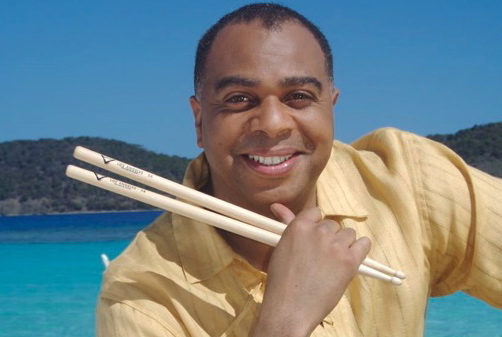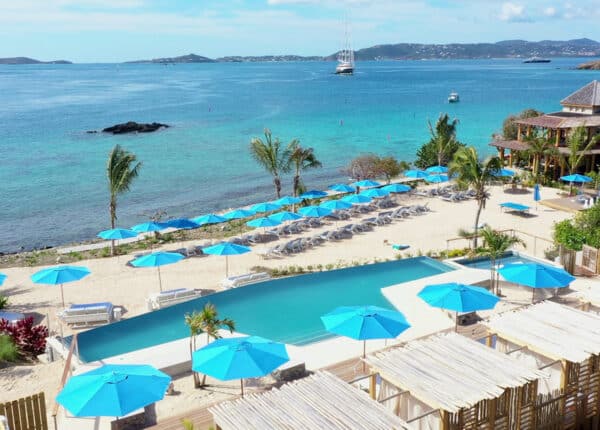How Grammy Winner Dion Parson is Bridging Jazz and the Caribbean
By Alexander Britell
It’s not easy to innovate in any musical genre –- but Grammy-winning drummer Dion Parson, a native of St Thomas, is doing just that – bringing together the worlds of the Caribbean and jazz and creating what is a truly unique sound. Parson, who is working on his latest album with his 21st Century Band, a recording of performances at the world-renowned Dizzy’s Club Coca-Cola in New York City’s Jazz at Lincoln Center, has been traveling between New York and the US Virgin Islands for decades. Now, he’s doing more – with a jazz education programme in schools across St Croix, St Thomas and St John, and trying to fill what he sees as a void and a desire for jazz in the islands. Caribbean Journal talked to Parson about his music, the state of jazz in the Caribbean and the challenge of innovation in jazz.
How would you describe your sound?
Well, the music of my band is a fusion between traditional jazz, harmonies and a style of playing which is an improvisational format, and Caribbean-based rhythms, and that would be rhythms of the various Caribbean islands – not just Latin Jazz from Cuba, Puerto Rico and the Dominican Republic, or just reggae stuff from Jamaica, but incorporating the calypso rhythms from St Thomas and Trinidad, in Soca and Quelbe, which is an indigenous form of music from St Thomas. Also, different types of mento styles, some Brazilian and some reggae also. It’s a true fusion of Caribbean rhythms and jazz harmonic style of playing.
How much did growing up in the Caribbean impact your sound?
It’s the basis of my music. Because that’s what I knew growing up. I had my first encounter with jazz when I was 14 years old, and I had the pleasure of hearing the Rutgers University Jazz professors that were traveling during a tour. And that was the first drumming I ever heard in my life. Then I moved to New York, went to college in New Jersey and got in the jazz scene right away. Immediately, I was always connecting back to home – every chance I had to go back home I would, and play with local guys. There was a void – something missing, that I always felt needed to be addressed. There was all this Caribbean stuff and all this jazz stuff that I was doing, but no bridge – so the Caribbean, St Thomas and particularly the Virgin Islands have been the basis of my influence and the creative force that has been the catalyst for putting my band together.
How much has the Caribbean impacted jazz?
It has impacted it a lot. There’s been a lot of musicians from not only the Virgin Islands, but mainly from the Caribbean, that have had influence that impacted jazz – the great Roy Haynes, his family is from the Caribbean – I think the Bahamas. But first Sonny Rollins – his famous tune “St. Thomas” set the standard right there for Caribbean jazz, without having a category for Caribbean jazz. And then Dizzy Gillespie’s collaboration with all of those great Cuban drummers in the 40s, and came up with Latin Jazz. There’s been a lot of influence. That has had its effect on Caribbean jazz and Caribbean people. I had the pleasure of working with Monty Alexander, and he’s been doing that for many years. Through my association with Alexander I met the great [Jamaican guitarist] Ernest Ranglin, who really helped me to focus on the history of the Caribbean and Jazz, and the path that was never really explored by many musicians. So there’s a big influence there – and all the cats in my band are from either the Virgin Islands or the Caribbean or from Africa. So the world music, Caribbean connection has a big impact on the scene also.
What are you working on right now?
Well right now I’m in the process of putting together the music for the next CD, which we had the good fortune of recording a month ago at Dizzy’s Club Coca-Cola, so I’m working on that, and doing the business to get all of that together, to get the rights for the CD out. I’m in the process of listening to those tracks, and getting ready to start editing, and working on the next major gig Thanksgiving weekend on St Croix. I’m also working on a drum book of my own transcriptions for the various CDs I’ve done, to explain how to take these various Caribbean rhythms and embellish them in a jazz format, which is something that has never really been done in Caribbean music or rhythmic music.
Talk about your jazz education initiative in the USVI.
Right now, I’ve been developing a programme in the Virgin Islands that is called “Mentoring through the Art of Music.” And this is an extension of what I’ve been doing on my own since I left the Virgin Islands. Since 1995, going back three or four times a year, and going into the different schools, I would just call various band directors up and ask them If I could come into the schools and talk to the kids and bring my drums and do a workshop. I would donate whatever instruments they need – and so I’ve been doing that for basically 16-17 years on my own. And I got involved with the Virgin Islands Lottery, which is an integral part of the Virgin Islands community. Down there, they donate a lot of money to education, and they decided to sponsor what I was doing, and work with them. So I go on all three islands – St Croix, St John and St Thomas – and, five times a year, with local musicians and present a jazz programme in the schools. And we’ll have the kids come and play with us and always play different styles – blues and rhythm changes, different styles of jazz – call and response, riff playing, and introduce the kids to that. That’s something I never had and we never had – we kind of figured it out on our own. So this is a way to support local music, what they’re doing, and teach the kids in the school and brighten them into having the ability to perform. So it’s a 360-degree proramme that I do to serve the community.
How would you describe the culture of jazz in the Caribbean?
Well, each island has its own thing. I can’t really speak for islands like Cuba, which has a tremendous education component down there – and they put out a lot of great musicians – but the various islands I’ve been to – Trinidad, St Kitts, the Virgin Islands, St Martin, Curacao, Aruba, most of these islands have jazz festivals, and a lot of local musicians playing Jazz, and a lot of guys that went away to the US or Europe and studied. So there is a love and a warmth and a need for the music in the Caribbean islands – but it’s not as accessible as in America. Culturally, each island is different – what might be called calypso on one island, might be called soca on another. But there’s a lot of highly educated folks on all the islands that have traveled, and been away and experienced different cultures – whether classical music or jazz music, and went back to the islands, and yearn for jazz. So what we have created is this cultural component in the music, of this indigenous music to the islands, and have put this jazz flavour on it, and everyone that has heard it has readily been very, very supportive, and appreciates to know that it is coming from the Caribbean, that the music of that culture is being taken seriously, and presented on a nice, highly sophisticated level.
What is the challenge of bringing together the Caribbean sound and jazz?
It’s been a trial and error type of situation. I’ve tried gigs, and guys look at me and say “what the hell are you playing.” I say, I can’t do that anymore. So it’s been trial and error, but I think once more guys from the Virgin Islands kind of moved into town and got together and sat down and said, “let’s do this,” it became a catalyst. I would sit at home and write music and try to hear stuff, and say, “let’s write a song with this type of vibe, but put this Caribbean thing on it,” and that’s been a great venue for us to be able to do that. It’s been a trial trying to present it, because it’s so unique, and that’s not the first thing – you can’t go to a jazz concert and say “I’m going to open with the Caribbean.” But over the years, we’ve worked at Dizzy’s [in New York] and we’ve been very grateful for them to give us this platform and showcase the music – it’s been a showcase to really present what we’re doing. They’ve been very supportive in us doing that. The last CD was Volume 1, and now we just did sort of a Volume 2. So that tells me there’s interest, there’s a curiosity, there’s a need and there’s a respect and support for what we’re doing on that level.
How hard is it to bring a new sound to jazz music?
I think it’s a challenge. I’ll put it this way. I write music that I like to hear. When I go out, when I’m listening to the radio and I hear groups and say, this is this young guy playing, and I can’t identify the sound of who it is – and I say, “that drummer sounds like this person,” who’s another young guy I’ve heard – everybody sounds the same, and it’s very rare that you hear someone that’s very unique. Because, musically, and I don’t know how to put it – I don’t get the feeling like guys are challenging themselves and saying, “what can I bring to the music?” I find myself trying to hear more indigenous music, hoping it might have some jazz incorporated with it. I have my favorite guys that I love to hear, but it’s difficult when I go out to hear something, and it’s like okay, I’ve heard that already. Not to say that guys aren’t bringing something to the table, but, stylistically, my personal feeling is we are all put on this planet with a uniqueness to bring to the table.
How do you build that bridge?
One of the new tunes we’ve added is “What a Wonderful World,” which is looked at as like, Louis Armstrong, that’s him. But I wrote an arrangement of it, and it’s a reggae style, all about Bob Marley, and once it dropped everybody loved it. It’s so unique, and the average person that may not listen to reggae would listen to this. And the average person that wouldn’t listen to jazz, would listen to this. So I think one of the things, the goals that we have made for ourselves as a band, and for me personally as a band leader, is to connect those two worlds. A lot of my friends come out to hear me play, and say, “I don’t like jazz, but when I hear you play, I start to tap my foot and listen.” I think it’s a unique format that we have together, and it’s really bridging the gap between the various cultures, that I think needs to be bridged.







